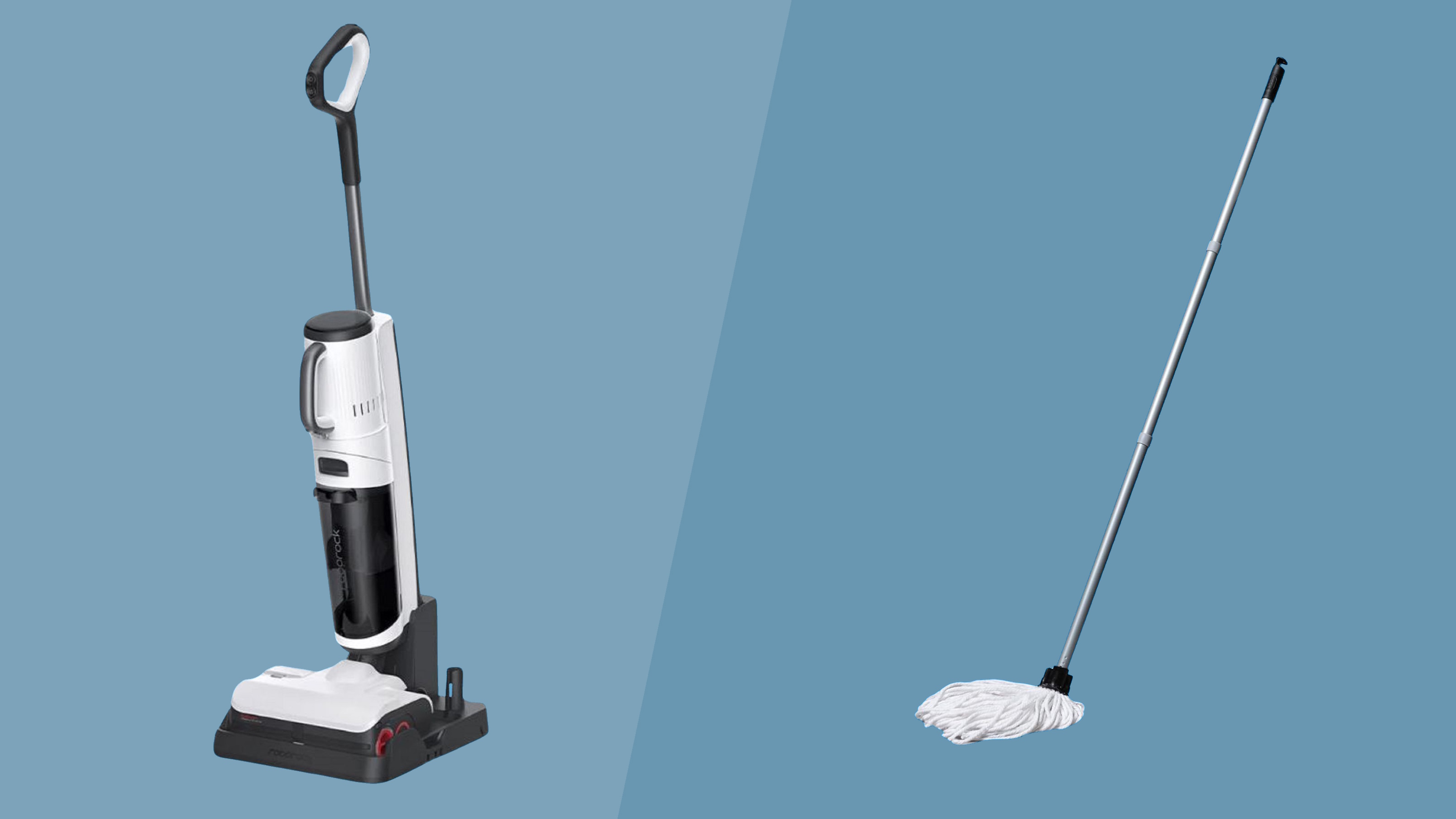
You might be torn between traditional mopping and modern wet vacuuming when keeping your hard floors clean. Both methods have their merits, but which is right for your home?
Over the last couple of years, I've tested over a dozen wet/dry vacuums from top brands in my home. I’ve found that the best wet/dry vacuums have come a long way. From self-emptying and self-cleaning robot vacuums that mop and vacuum your floor without you lifting a finger to vacuums that can even tackle your upholstery and valet your car, it’s clear to me that if you want a new appliance that has multiple uses around the home, a wet/dry vacuum is a no-brainer.
Having said all that, not all of us want an all-singing, all-dancing appliance. We just want to clean our floors as quickly and as efficiently as possible. And not everyone has the budget for premium features like self-cleaning and self-drying. With that in mind, I’ll take you through the key differences between wet/dry vacuums and mops in terms of their uses, design, features, and capabilities so you’ll have a better idea of whether you need a mop or a wet/dry vacuum to meet your household’s needs. I’ve also spoken to some cleaning industry pros for their expert insight.
Mopping vs wet vacuuming: price & value
- Steam mops are cheaper than wet/dry vacuums, which can be expensive but offer long-term value.
- Increased productivity makes wet/dry vacuums worthwhile, despite their higher initial price.
When comparing costs, even the best steam mops are much cheaper than wet/dry vacuums. Basic models can be found for just a few dollars. Wet/dry vacuums, however, can be expensive, ranging from moderately priced models to advanced ones costing thousands.
Although the initial investment in a wet/dry vacuum is higher, the long-term value it provides is essential to consider. Using a wet/dry vacuum can save you money over time by replacing several other cleaning tools. For more insight, I spoke with Delah Gomasi, the CEO and managing director of MaidForYou.
Gomasi says even the cheapest wet/dry vacuum will outperform the cheapest mop in terms of cost per use. A mop head needs to be replaced after about ten uses, whereas a wet/dry vacuum can last up to five years with regular use.
Riley also says, "While a vacuum mop can be ten times more expensive than a traditional mop and bucket, the increased productivity justifies it."
Mopping vs wet vacuuming: Features & functions
- Mops are versatile for various surfaces, ideal for occasional spills.
- Wet/dry vacuums offer more features for diverse messes but require more storage space.
Mopping involves manually wiping floors with a wet mop, while wet vacuuming uses suction power to remove wet and dry debris.
As a cleaning expert and co-owner of Impact Cleaning Professionals, Taylor Riley says, "My first tip for any household is to have a mop and bucket." Riley explains that a mop and bucket can provide a thorough cleaning if you don't have a wet/dry vacuum. However, a vacuum mop can improve efficiency and provide a better clean. For spot cleaning, grab a vacuum mop instead of a mop bucket.
Wet/dry vacuums are great for general household spills and cleaning because they combine wet and dry cleaning into one job, leaving the floor super clean. Riley says, however, that they're hard to use for cleaning corners and scrubber stubborn, set-in debris, so a mop is better.
Those messes, like pet accidents or foul-smelling spills, can be easily cleaned with mop heads. They're easy to clean, usually just a handle and an absorbent head. Mops are versatile and can be used on a lot of surfaces, including floors, walls, and even ceilings. Some mops come with interchangeable heads.
Some wet/dry vacuums have self-emptying and self-cleaning capabilities, while others come with attachments for cleaning upholstery, washing carpets, and even unblocking drains.
A mop and bucket are compact and can be stored almost anywhere, but a wet/dry vacuum is usually much larger.
If you have little storage space and need to clean floors occasionally due to spills or messes, you could use a mop. However, if you have enough storage space and need more versatility for handling different messes and surfaces, you might get a wet/dry vacuum.
Mopping vs wet vacuuming: Performance
- Mopping is labor-intensive, requiring pre-cleaning and ongoing maintenance.
- Wet/dry vacuums combine vacuuming and mopping, saving time and effort.
The differences in the effort required for mopping versus using a wet/dry vacuum are quite noticeable. Mopping is generally light and easy to maneuver but it still requires some physical effort. You'll need to vacuum or sweep the floor before mopping, particularly if you have really dirty floors. The mopping process is labor-intensive. Rinsing the mop head and dumping the dirty water after mopping add extra steps to the cleaning process.
Cleaning can be much easier with a wet/dry vacuum. These vacuums combine the functions of vacuuming and mopping into one step, so there's no need for separate dry cleaning before cleaning wet messes. This saves a lot of time and energy, especially when cleaning large areas.
“I use a wet/dry vacuum every day to quickly clean heavily trafficked areas,” Riley says. “Especially around the dinner table where our toddlers spill food and liquids often. To make sure all the edges, corners, and stubborn parts are spotless, we clean with a traditional mop every two weeks or so."
Advanced wet/dry vacuums offer even more convenience. Robot vacuums like the Eufy X10 Pro Omni can clean your floors, return to their docking stations, empty themselves of dirt and water, and even wash and dry their mop itself. For those with busy lifestyles or limited mobility, this hands-off approach can be a game-changer. Set up cleaning schedules, designate no-go zones, and designate areas for deep cleaning.
Petya Holevich, a cleaning expert and supervisor for Fantastic Services, explained the benefits of wet/dry vacuums in terms of physical effort and ease of use.
Holevich says the mop works slower and takes more effort to use. "You have to exert a lot of force to wipe a surface, often using both hands. It's even harder because you have to dip and wring out the mop constantly."
A wet/dry vacuum is much faster and easier to clean. A wet/dry vacuum model can cover a large area three to four times faster. It also makes sense to own a vacuum cleaner that can handle various floors, from hardwood to laminate to carpet.
Some canister models with large water tanks can be heavy and difficult to maneuver, which may pose difficulties for some users.
Mopping and buckets are compact and easy to store, but wet/dry vacuums with multiple attachments require more space.
While mops are usually easy to handle, they can't pick up dirt and debris, so you'll need to vacuum before using one. Mopping is a lot of work, especially on dirty floors. Additionally, you have to wash the mop head and throw away the dirty water.
With a good wet/dry vacuum, you don't have to worry about that much. The Eufy X10 Pro Omni robot vacuum can clean up any mess and then empty the dirty water and debris into its self-emptying station while cleaning and drying its mops, too. Some wet/dry vacuums, especially canister models with large water tanks, may require some upper body strength to move around.
In Sydney, Australia, MaidForYou's Managing Director & CEO Delah Gomasi says wet/dry vacuums are more versatile, while traditional mops are simpler. Wet mops, however, require less maintenance and tend to be easier for consumers to use. You have to empty the dust bag, change the HEPA filter if it gets overused, and do regular maintenance if you want it to work properly."
If you're busy and want to minimize cleaning time, consider a robot wet/dry vacuum. You can set cleaning schedules, define no-go zones, select areas for deep cleaning, and schedule evening cleaning sessions.
Mopping vs wet vacuuming: Maintenance
- Mopping is more energy-efficient and environmentally friendly than wet vacuuming since it relies on manual labor and no electricity.
- While wet/dry vacuums can conserve water, they typically use more energy.
Mopping is more energy efficient and has a lower environmental impact than wet vacuuming. A standard mop is more energy efficient than a shop vacuum or wet/dry vacuum because it doesn't need electricity. Wet/dry vacuums may be cordless and battery-operated, but they are not as energy-efficient as traditional wet mopping.
Mopping is more energy-efficient because it relies solely on manual labor. While you'll need electricity to use a wet/dry vacuum, many models are designed to save energy. When you're picking a vacuum, look for models with energy-saving features or an Energy Star label. Robot wet/dry vacuums can also be programmed to clean during off-peak hours, potentially reducing energy costs.
In the U.S., mops usually use a lot of water, with bucket sizes ranging from 2 to 5 gallons. However, many wet/dry vacuums can achieve similar results with much less water, often just a quarter of a gallon. This is crucial if you're trying to conserve water.
In the UK, Factory Direct Flooring's managing director Paul Hambidge says, "The environmental impact of using a wet/dry vacuum varies from model to model." He recommends reading the product descriptions for eco-friendly technology and green credentials. In general, wet/dry vacuums use more energy than mop and bucket because they need power and water.
The good news is that wet/dry vacuums use much less water than traditional mops and buckets. They need only a quarter of a gallon to achieve the same level of cleanliness as buckets, so if water conservation is important to you, a wet/dry vacuum might be a better choice.
Mopping vs wet vacuuming: which is better?
Both mopping and wet vacuuming are helpful in home cleaning. Mops offer simplicity, affordability, and versatility for various cleaning tasks around the home. They're great for quick clean-ups and don't require much storage space.
Wet/dry vacuums, on the other hand, have evolved into powerful, multi-functional tools capable of efficiently tackling tough spills and stains. They offer convenience and efficiency, especially for homes with pets, children, or frequent spills.
Your choice ultimately depends on your needs, budget, and available storage space. A mop is sufficient if you're looking for a simple, cost-effective solution for occasional cleaning. However, if you want a versatile cleaning tool that can handle various surfaces and messes, a wet/dry vacuum could be a worthwhile investment that significantly reduces the physical labor of keeping your floors clean.
Mopping vs wet vacuuming: FAQs
Is a mop or wet dry vacuum better for edge-to-edge cleaning?
While many wet/dry vacuums can get super close to the edges of floors, with some leaving only a few millimeters of uncleaned floor, mops can generally do a better job on edge-to-edge cleaning. But there’s no reason why you can’t quickly run a mop around the edges of your floors before or after your wet/dry vac to get 100% surface cleanliness and peace of mind.
Which is more hygienic - mopping or wet/dry vacuuming?
A wet/dry vacuum is generally more hygienic than a mop and bucket. It uses only clean water to wash your floors, while dirty water is siphoned into a separate tank. On the other hand, a mop requires you to use the same water repeatedly, running the risk of spreading dirt and germs across your floor.
"Mops don’t remove dirt from the surfaces you’re cleaning but rather distribute it around," says Holevich. "There has even been research that showed that regular mops can leave between 30 to 60% of dirt behind after you’ve finished cleaning. Also, the mop and bucket you have to dip the cleaning tool in become dirty as soon as you start cleaning and continue to grow increasingly dirtier. This usually happens regardless of how many buckets you use. On the other hand, a wet-dry vacuum can eliminate almost 99% of dirt and leave the surfaces you’re cleaning uncontaminated."







